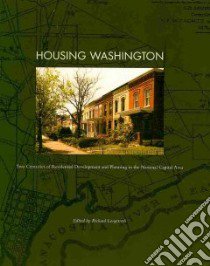Housing Washington - 9781935195078
Un libro in lingua di Longstreth Richard (EDT) edito da Univ of Chicago Pr, 2010
- € 42.40
- Il prezzo è variabile in funzione del cambio della valuta d’origine
"Richard Longstreth and his collaborators offer a rich and incisive architectural history of Washington, D.C.'s residential landscape. The book ranges broadly across time, place, and the changing forms of architectural production. It will be a joy to read for general and specialist readers, for neighborhood residents, as well as university scholars. This book brims with fresh historical insights and new ways of looking at the world around us. Many historians of American architecture and urbanism will wish they had contributed to this important collection. They will find in these pages a compelling new model for coming to terms with the architectural and landscape form of American cities." --- Daniel Bluestone, Associate Professor of Architectural History, University of Virginia
"Richard Longstreth has orchestrated some of the finest scholars available to produce a model text for the analysis of a metropolitan region's domestic architecture. The book is uniquely organized to address the major, common types of domestic architecture, including suburban housing, and the contributions of African Americans, as well as Washington's claim to visionary and reform architecture that influenced housing throughout the United States. Housing Washington is a model for a seldom realized comprehensive analysis of a major city's urban/metropolitan housing." --- Thomas C. Hubka, Professor of Architecture, University of Wisconsin-Milwaukee
"Richard Longstreth's Housing Washington brings together an impressive array of sites and topics. Each richly textured essay juxtaposes and connects multiple perspectives: builders and architects, developers and community groups, reformers and officials, blacks and whites, trends and anomalies, building patterns, and the natural landscapes they inevitably affect. The collective portrait helps us understand housing as a dynamic, diverse, sometimes inventive, and always contested realm of American public life." --- Gwendolyn Wright, Professor of Architecture, Columbia University
Since the early nineteenth century, an unusually rich and varied array of housing stock has been created in the Washington, D.C., metropolitan area. Examining this legacy tells us much about the development of the nation's capital, as well as what has become one of the nation's major population centers. Housing Washington covers significant aspects of the subject, from the early nineteenth century to the present time. The essays address two overarching, complementary spheres: housing patterns that were common to the area and projects that were conceived as new models locally and, often, nationally.
"Washington has harbored numerous private-sector initiatives to develop model housing projects, and it also has been a proving ground for federal policies crafted to improve living conditions for households of middle and moderate income. Although Washington is often recognized for its conservatism in architecture, the city was, in the twentieth century, an incubator for Modernism both in the planning of residential developments and in housing design.
The large middle-class, African-American population has left a distinct imprint on the metropolitan area's domestic landscape. During the late nineteenth century, this demographic contingent began to develop its own options for housing in city and suburb alike. During the mid-twentieth century, Washington's black middle-class also played a key role in the gradual erosion of racial barriers in the residential sphere.
Profusely illustrated, Housing Washington breaks new ground in architectural history, urban studies, and planning history. By focusing on a wide variety of mainstream patterns and on others intended to become so, interweaving the threads of convention and change as well as those of race and class, the book offers a fresh perspective on metropolitan dwelling places.
Informazioni bibliografiche
- Titolo del Libro in lingua: Housing Washington
- Sottotitolo: Two Centuries of Residential Development and Planning in the National Capital Area
- Lingua: English
- Autore: Longstreth Richard (EDT)
- Editore: Univ of Chicago Pr
- Collana: Univ of Chicago Pr (Hardcover)
- Data di Pubblicazione: 15 Aprile '10
- Genere: SOCIAL SCIENCE
- Argomenti : Housing development Washington Metropolitan Area History Housing policy Washington Metropolitan Area History Housing Washington Metropolitan Area History
- Pagine: 394
- ISBN-10: 1935195077
- EAN-13: 9781935195078


